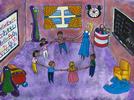Log of Field Experiences:

![]() Art
Art
For this medium, I worked with children at a small medical clinic where I am currently employed. While I tried this medium with a few different children (refer to videos presented in class), I will discuss my interactions with Caroline. Caroline is a sweet, bright, 8-year-old girl who was enrolled in an intensive language/reading program at the clinic. To attend this program, she was pulled out of school for 9 weeks. Our meeting was timely, as Caroline was scheduled to return to school the following week.
![]()
At the beginning of our meeting, I asked Caroline to draw a picture of an animal she felt was like her in some way. Caroline understood the request and began to work immediately. Instead of using paper and markers, we used foam soap on a large vertical mirror. The animal she chose to create was a bunny rabbit, and she described the bunny as “quiet” and “shy”. I asked Caroline if she could remember a time when she felt quite or shy, and she said “no”. I then shared that I remembered feeling shy when I had to start a new school and make new friends. Caroline agreed with this and shared that she was nervous about returning to school, especially since she would be with a new teacher. Caroline also discussed how she was concerned because she was unsure of what the teacher's expectations would be, and which peers would be in her class. During this time, I tried to ask how and what questions, and make clarifying responses. Then, I began to apply part of the Problem Solving Model, asking Caroline to think of things she could do to make the transition to her new classroom more comfortable. With help, Caroline came up with finding out what the classroom rules are and finding out which friends are in the class. When asked about her next step, Caroline said that she would ask her mother to contact the teacher and find out that information. At this point, our scheduled time together was almost up; so I thanked Caroline for talking with me and helped her clean up the art supplies.

At the beginning of this activity, I felt a bit awkward. I had been working with Caroline for several weeks, but as an occupational therapist. Switching from O.T. to counseling student, and asking her to try a completely different activity from what we usually do was strange at first. After the activity got started, however, I felt more comfortable, especially as Caroline began to share her concerns about returning to school. I could relate to her feelings, and I felt like she understood this. I did notice that I had to redirect myself to “stay in the moment” at times, instead of thinking about what to say next.
This experience
with Caroline really reinforced the idea that the activity is just the
“starter” for the counseling session. We worked on the foam soap
animals for just a couple of minutes, but the resulting conversation lasted
much longer. From my first session with twin boys, I also learned
how the media could be manipulated to meet the needs of different kids,
allowing those with language impairments to have a way to express themselves.
Regarding myself, I re-learned that some session go smoothly, while others
go “haywire” (probably the latter more than the former when you are a new
counselor). I do feel like my previous experience with kids allows
me to feel more comfortable with the “haywire” times.
![]() Music & Movement
Music & Movement
For this medium, I again worked with children from my job. James and Arthur, both age 7, were my willing participants. Both children were previous students in the clinic’s intensive program and have now returned to school. They attend the clinic after school for tutoring, language, and occupational therapy. We worked together for approximately 30 minutes in a large, open room with matted floors and large pillows.
![]()
I introduced the activity by talking about pleasant and unpleasant feelings. By using basic words (mad, happy, sad, excited), the boys quickly caught on and began to distinguish between the two categories. Then I played a short piece of music by N’SYNC (a favorite group of both boys) and encouraged them to get up and move around or dance. They did not need me to ask twice, as they quickly began to imitate N’SYNC’s dance moves! After I stopped the music, I asked James and Arthur to describe how the music and dancing made them feel. James said “energized” and “awake”, and Arthur replied “hyped up” and “good”. Then I asked them to consider whether their feelings were pleasant or unpleasant, and they both gave me a resounding “pleasant!” I repeated this process with other types of music, including classical, rap, nature, and action movie soundtrack pieces. After the classical piece, James said that the music made him feel “tired and sad” (he labeled these feelings unpleasant), while Arthur said the music made him feel “relaxed and un-stressed out” (he labeled these feelings pleasant). I used this avenue to discuss how two people can experience the same event, but feel differently about it. Then I asked the boys if they could think of a time when this happened. After scratching their heads for a couple of minutes, Arthur said that he and his friend felt differently after watching the same movie. James recalled how he and his brother felt differently about having to move to a new town with their family. During this time I tried to reduce my questioning and focus on feeling-focused responses and clarifying responses. After the action movie piece, Arthur reported feeling “scared” and “excited”. When asked to label these as pleasant or unpleasant feelings, Arthur said scared was unpleasant, but excited was pleasant. James asked Arthur how he could be feeling both pleasant and unpleasant feelings at the same time. This led us into a discussion about how we can experience conflicting feelings at times, and after a brief period of time both boys were able to name several examples (i.e. first day of school, going away for the summer to visit parent/relatives, or starting a new sports team).
![]()
While working with the boys and this medium, I felt pretty comfortable. I participated in the activity with them, dancing and moving around the room. The conversation was lively and I felt like the boys were participating equally. I have worked with these boys for several months, so I felt like we had a good rapport and we joked with each other frequently. Because we had a good rapport, I also think that the boys felt that they could be honest about their opinions regarding the music and how it made them feel. I would have liked to make more of a LEAP into daily application, however, I was pleased with the everyday examples the boys were able to generate.
I learned that
this medium was a good choice for this pair of boys, especially since they
enjoy lots of movement (it is actually hard for them to sit still).
I also surprised myself with how comfortable I was dancing and moving around
the room!
![]() Guided Imagery
Guided Imagery
This medium was the one I was least familiar with, and because of that, least comfortable with. I worked with siblings Alan (age 16) and Cassie (age 14) at their house. I had previously met Alan and Cassie as I used to work with their mother. While Alan appeared interested and open at the beginning of the session, Cassie seemed a little more skeptical and reserved.

Throughout the session, a “nature sounds” CD was playing in the background. After setting the climate with some brief relaxation exercises (for example, tensing and relaxing different muscle groups, focusing on breathing, and picturing a calm, quiet place), I moved into the guided imagery. The guided imagery I chose asked Alan and Cassie to imagine waking up in the morning and discovering 10 years had past. I asked them to think about where they were and what their room was like, and then asked them to imagine getting up and walking into the kitchen. When they reached the kitchen I asked them to imagine who was there. Giving them time to make visualizations, I then told them that their calendar is up on the wall, and I asked them to imagine what they have scheduled for the day. The entire visualization took approximately 5 minutes.
After I asked them to open their eyes, Cassie was eager to share what she pictured. She saw herself in her bedroom, in her apartment in New York City. She pictured having fancy, designer clothes all lined up in her closet, with matching shoes. When she walked to the kitchen, she saw her best friend. When she looked at the calendar, she saw that she had a court appointment scheduled. She imagined herself as a rich, successful lawyer.
Alan was also agreeable to sharing what he pictured. He saw himself waking up in a “phat pad” and living with 3 of his best friends. He described his bedroom as having a “comfy bed” and a big screen television with a satellite dish attached. When Alan looked on the calendar, he saw concert practice on his schedule. Following concert practice was work and then a date in the evening. He saw himself playing the saxophone as part of a band, while also stating that he would probably also have to do some other work, “like waiting tables or delivering packages”.

During their descriptions I asked how and what questions and made feeling focused and clarifying responses. I used the information from the guided imagery to ask Alan and Cassie to think about what they would need to do in the next 5 years to get to their 10 year goal. Cassie talked about performing well in school. Alan was able to be a little more specific, citing how much more he would need to practice to get into a good music program at college. He also brought up that he might want to be an orthodontist instead, and just play music as a hobby. For this he felt that he would need to work harder in school, to get into a good college. Specifically, he talked about needing to improve his math and science grades.

Though I was not very comfortable during the actual guided imagery, I enjoyed working with Alan and Cassie. Since most of my experience has been with younger children, it was refreshing to talk with young adults who were capable of deeper thought and problem-solving. Talking with these two about their future careers reminded me of my previous interest in career counseling, and it caused me to re-think where to complete my fieldwork experiences.
Through the
class presentation and my experience with guided imagery, I learned how
adaptable the medium is and how it can be a non-threatening avenue to disclosing
information.
![]()
![]() Puppets
and Dolls
Puppets
and Dolls
I used puppets to work with two 9-year-old boys who have been diagnosed with ADHD. At work, I use a program called "How Does Your Engine Run?" to help children identify when their activity level is "high", "low", or "just right" for learning. Then, they begin to learn different strategies to help change their "engine speed" to "just right", if needed. These two boys were having difficulty recognizing and labeling their own engine speeds.

First, I had the boys make their own puppets out of brown paper lunch bags. Adam and Mike used markers, felt, and yarn to decorate their puppets. They both seemed to enjoy personalizing their puppets- while Adam said he was making his puppet resemble himself, Mike said that he wanted his puppet to be a dinosaur. Next, using a paper bag puppet I had made prior to the session, I introduced my puppet (using my puppet voice) and asked the boys to introduce their puppets. Then, using my puppet, I briefly reviewed the concept of engine speeds and how to identify them. I asked the boys to show me what their puppets would look like in the different engine speeds, and then we played an engine speed guessing game. For this, one of us used our puppet to act out a speed and the other puppets would have to watch and then guess what speed it was.
After the guessing game, we discussed how the boys were able to identify the engine speeds of the puppets. Adam and Mike commented on things like the position of the puppet, how the puppet was moving, and what the puppet was saying. I asked Mike and Adam if they could think of times when they felt like their engine was too high or too low for learning. They were able to give a couple of examples, such as waking up in the morning after not sleeping well (low engine), or getting in to a fight (high engine). At this point, I asked Mike and Adam how others would know that they had a high or low engine (focusing on behaviors) and asked them to act them out. I was trying to have the boys take the behaviors that they identified earlier with the puppets and apply them to their own bodies.

I felt like the puppets were valuable as a teaching tool in this activity, and Adam and Mike responded positively to them. They both asked to take their puppets home. I think that the use of puppets was appropriate for this activity, however, I think that they will need reinforcement of the engine speed concepts through other methods. I enjoyed this activity and felt at ease during the session. I think it was very helpful that I was already quite familiar with the program I used with the puppets. I felt comfortable adapting the program and the dialogue during the session. If I use the puppets for this program again, I think that it would be beneficial to obtain puppets with arms and legs to emphasize body language.
I learned that
people of all ages can enjoy puppets, as observed during my session with
Adam and Mike, and during our class. I was very interested in how
Adam and Mike were able to make their puppets act out various engine speeds
with minimal difficulty, yet continue to struggle with identifying their
own speeds.
![]()
![]() Creative
Dramatics
Creative
Dramatics
For the creative dramatics medium I wanted to work with a small group of middle school kids at my job. Unfortunately, I was not able to arrange the schedule so that they could all come at the same time. Instead, I worked with a 17-year-old girl named Andrea. Andrea had "taken a leave of absence" from high school due to a mood disorder (depression). While Andrea had plans for the future, including getting her G.E.D. and enrolling at Santa Fe Community College, her immediate goal was to find a job.

Andrea applied to a few different places, including a yogurt shop, a shoe store, and a discount store. When we met, she was concerned about the interview process. Specifically, she was unsure about how people would react to the fact that she had not finished high school. I suggested that we try a role play, with Andrea being the interviewer and me being the interviewee. I encouraged her to act the way the interviewer would be in her worst case scenario. I figured that it would give me a brief opportunity to model how to respond to tough questions. Andrea was more than happy to try this out. She grilled me with questions such as, "Why should I hire you? You're just a high school dropout", and "How can I consider you to be responsible if you didn't even finish school?". I could really sense how much not graduating was on Andrea's mind.
My original plan was to then switch roles, and I would interview Andrea. However, because of the recurring negative comments and the theme of failure, I decided to go with that instead. I said something like, "Wow, I'm hearing your concern about how others will perceive you because you haven't graduated from high school. Tell me more about that". This led to a deep discussion about how Andrea felt as she watched her friends go through their senior year of school, knowing that she would not be able to graduate with them. I had to really fight the urge to try to tie up loose ends at the conclusion of our time together and end on a happy note. I recognize that not all discussions are happy ones, and I sensed that Andrea was not at a place to be pacified by clichés. I did try to get her thinking about her strengths, inner resources, and sources for support.

I saw Andrea again later that week, and she commented on how it was helpful for her to talk about her feelings. She stated that she did not realized how much emotion she was holding back. Andrea also felt ready to do more work preparing for job interviews, so I ended up using the Problem-Solving Model with her and providing her with additional resources.
During my time with Andrea, I felt comfortable with how things were going initially. I even felt comfortable deviating from my original plan and talking about her feeling regarding not completing school. I was surprised , though, with how quickly the tone of the conversation changed (from casual and light-hearted to emotion-laden) when I went from her presenting problem to the real issue. I could tell at that point it began taking me longer to formulate my responses. This is an area that I will need continued work in.
I felt really
good about using this medium. I learned that it can be a practical
way to practice skills, and also a powerful way to facilitate dialogue.
I am interested in trying a more involved creative dramatics experience,
perhaps like the one we put on our Play Counseling
Interventions page- Adventures
in the Land of Grief.
![]()
![]() Games
Games
Alan (who also participated in the Guided Imagery Experience above) and Drew (age 13) were the two boys I worked with for this medium. The game I planned involved constructing a small bridge out of connecting pieces (similar to Tinker Toys) following a color-coded picture. For their first attempt, I asked them to complete the bridge without talking. There were additional rules in place, such as the order in which to put the pieces together and who could touch what pieces, just to make it a little more challenging. I also timed the activity so that there was a sense of urgency. It was fun to watch the boys complete the bridge- they had a hard time understanding each other's gestures and grunts! Also, Drew repeatedly tried to take pieces from Alan (which was against the rules) and just put the bridge together by himself- definitely a lot of potential for discussion.

After they completed the first bridge (which took several minutes), they laughed about how hard it was to get their ideas across when they could not talk. I commented on how Drew wanted to take the pieces from Alan, and Drew reported that he was really competitive and wanted to get the job done quickly. We briefly processed what that experience was like for Alan, also. Next, the boys were given a similar bridge to build, however they were allowed to talk freely this time. They completed the bridge in a shorter amount of time, and they reported less frustration and stress.
I asked the boys to compare the experiences. Alan said that while building the first bridge it was like they were working separately, while it seemed like they were more of a team working together to build the second bridge. Drew commented that it was difficult for him to communicate through gestures, so he felt relieved when he could talk again. Then I asked the boys if they could think of a time when there was a lack of communication and it made them feel frustrated. Alan and Drew thought for a couple of minutes and then came up with a few examples including when friends try to make plans to go out as a group, making a schedule to use the car, and expectations with class projects and homework assignments. We spent a few minutes talking about what we could do to try and get better communication in those situations.

I had a good time with this activity. I can see where it could be very beneficial when discussing communication, frustration, or teamwork. It would have been interesting to see what the results would have been if the participants did not get along with each other. I felt comfortable throughout the activity and discussion, primarily because I had a strong rapport with both boys.
I really enjoy
games myself, and I look forward to incorporating them into counseling
sessions. This experience really reinforced how play can readily
be used as a learning opportunity and an opportunity for self-discovery.
![]()
![]() Humor
& Magic
Humor
& Magic
For this medium, I chose to work with magic tricks. First, I selected a book on children's magic from the local library, and taught myself to perform one of the tricks. It went something like this- when with a small group of people, tell them that you have a powerful mind that can predict what is written on paper. Ask everyone to give you their name, and act like you are writing them down on small scraps of paper (in reality, you just keep writing the same name of someone in the group on all of the papers). Acting casually, so no one sees what you have written down, fold all of the papers in half and put them in a small bag. Then, shake the bag, and turn to one of the group members. Ask them to draw one paper and look at it, without showing you the name. Then, making it look like you are thinking very hard, announce the name you had written on the papers. Voila! Everyone will be impressed with your magical abilities.
I showed this trick to a 9-year-old boy that I work with at my job. He receives occupational therapy two times per week, and he spends half of each session with another boy his age to work on social skills. I felt that Scott could definitely use something to boost his confidence around peers, as he is often the follower but rarely the leader. Additionally, Scott is a huge Harry Potter fan, so magic tricks fall right into his area of interest. I showed Scott the trick, using co-workers as other group members. Then, I explained the trick to him, step-by-step. It actually took us two sessions to get to the point where Scott was ready to practice. Again, I recruited co-workers to let Scott practice his new trick. Fortunately, Scott was very familiar with many of the staff members and he was excited about this. After a handful of repetitions, Scott felt ready to try the trick with a couple of peers (one peer being the boy he shares half of the therapy session with). It was a success! The other two boys had no idea how Scott had figured out the name on the paper. They immediately began to ask Scott questions, and Scott ended up sharing how to do the trick. It was the first time I saw him "have the upper hand" in a conversation.

After the "performance", I talked with Scott briefly about how he felt pulling off the magic trick successfully. He reported feeling "happy" and was grinning from ear-to-ear. He said, "Did you see how I surprised everyone!?".
Since that session, Scott has taken the initiative to learn two other magic tricks. I have also noticed a subtle difference in the interactions between the two boys during therapy sessions. Now, the other boy will often ask Scott at the beginning of their time together, "Have you learned any other tricks?" and if Scott has, he is willing to show him.
Although teaching the trick was a bit time consuming, it was certainly worth it. I was surprised and pleased with how well this medium worked out. I felt that Scott really benefited from learning the trick, and it changed his behavior, which led to pleasant changes in his feelings. Though I did not spend too much time developing the conversation afterward and making "LEAPs", I could definitely see that the potential was there.

From this experience,
I learned that it does not really matter if the trick is pulled off successfully
or not (though secretly I am always hoping that it is). No matter
what the result, it leads to conversation about what happened- once again
reinforcing that it is the process that is important, not the product.
